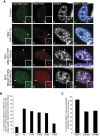SRSF1 regulates the assembly of pre-mRNA processing factors in nuclear speckles
- PMID: 22855529
- PMCID: PMC3442416
- DOI: 10.1091/mbc.E12-03-0206
SRSF1 regulates the assembly of pre-mRNA processing factors in nuclear speckles
Abstract
The mammalian cell nucleus is compartmentalized into nonmembranous subnuclear domains that regulate key nuclear functions. Nuclear speckles are subnuclear domains that contain pre-mRNA processing factors and noncoding RNAs. Many of the nuclear speckle constituents work in concert to coordinate multiple steps of gene expression, including transcription, pre-mRNA processing and mRNA transport. The mechanism that regulates the formation and maintenance of nuclear speckles in the interphase nucleus is poorly understood. In the present study, we provide evidence for the involvement of nuclear speckle resident proteins and RNA components in the organization of nuclear speckles. SR-family splicing factors and their binding partner, long noncoding metastasis-associated lung adenocarcinoma transcript 1 RNA, can nucleate the assembly of nuclear speckles in the interphase nucleus. Depletion of SRSF1 in human cells compromises the association of splicing factors to nuclear speckles and influences the levels and activity of other SR proteins. Furthermore, on a stably integrated reporter gene locus, we demonstrate the role of SRSF1 in RNA polymerase II-mediated transcription. Our results suggest that SR proteins mediate the assembly of nuclear speckles and regulate gene expression by influencing both transcriptional and posttranscriptional activities within the cell nucleus.
Figures






Similar articles
-
SR and SR-related proteins redistribute to segregated fibrillar components of nucleoli in a response to DNA damage.Nucleus. 2010 Jul-Aug;1(4):367-80. doi: 10.4161/nucl.1.4.12683. Epub 2010 Jun 16. Nucleus. 2010. PMID: 21327085 Free PMC article.
-
Identification of a chemical inhibitor for nuclear speckle formation: implications for the function of nuclear speckles in regulation of alternative pre-mRNA splicing.Biochem Biophys Res Commun. 2014 Mar 28;446(1):119-24. doi: 10.1016/j.bbrc.2014.02.060. Epub 2014 Feb 22. Biochem Biophys Res Commun. 2014. PMID: 24569078
-
The dynamics of a pre-mRNA splicing factor in living cells.Nature. 1997 May 29;387(6632):523-7. doi: 10.1038/387523a0. Nature. 1997. PMID: 9168118
-
Nuclear speckles: molecular organization, biological function and role in disease.Nucleic Acids Res. 2017 Oct 13;45(18):10350-10368. doi: 10.1093/nar/gkx759. Nucleic Acids Res. 2017. PMID: 28977640 Free PMC article. Review.
-
Nuclear organization of pre-mRNA processing.Curr Opin Cell Biol. 1993 Jun;5(3):442-7. doi: 10.1016/0955-0674(93)90009-f. Curr Opin Cell Biol. 1993. PMID: 8352961 Review.
Cited by
-
SON and SRRM2 are essential for nuclear speckle formation.Elife. 2020 Oct 23;9:e60579. doi: 10.7554/eLife.60579. Elife. 2020. PMID: 33095160 Free PMC article.
-
p53 mediates target gene association with nuclear speckles for amplified RNA expression.Mol Cell. 2021 Apr 15;81(8):1666-1681.e6. doi: 10.1016/j.molcel.2021.03.006. Epub 2021 Apr 5. Mol Cell. 2021. PMID: 33823140 Free PMC article.
-
The master energy homeostasis regulator PGC-1α exhibits an mRNA nuclear export function.Nat Commun. 2023 Sep 7;14(1):5496. doi: 10.1038/s41467-023-41304-8. Nat Commun. 2023. PMID: 37679383 Free PMC article.
-
A Cytoplasmic RNA Virus Alters the Function of the Cell Splicing Protein SRSF2.J Virol. 2017 Mar 13;91(7):e02488-16. doi: 10.1128/JVI.02488-16. Print 2017 Apr 1. J Virol. 2017. PMID: 28077658 Free PMC article.
-
Nuclear architecture and the structural basis of mitotic memory.Chromosome Res. 2023 Feb 2;31(1):8. doi: 10.1007/s10577-023-09714-y. Chromosome Res. 2023. PMID: 36725757 Review.
References
-
- Bourgeois CF, Lejeune F, Stevenin J. Broad specificity of SR (serine/arginine) proteins in the regulation of alternative splicing of pre-messenger RNA. Prog Nucleic Acid Res Mol Biol. 2004;78:37–88. - PubMed
Publication types
MeSH terms
Substances
Grants and funding
LinkOut - more resources
Full Text Sources
Molecular Biology Databases
Research Materials

